Environment Friendly Gardening
Minimize your impact on the environment Help the environment to help you to garden.
The second point needs a little explanation - A garden is an artificial construct in what should be a wild place. Any plants you put in it, particularly those that are not natives are invaders and will be seen as competition or food by the native plants, animals and fungi. If you destroy the natives too effectively, then biodiversity will fall, this is the variety of life that lives in your garden - despite the sound of this it is not a good idea as it makes it more likely that a pest or disease will run away with and destroy your favourite plant than if there are natural checks and balances to keep it under control. Green gardening maintains biodiversity which enhances stability and so becomes self-enhancing.
Grow insect and bird friendly plants
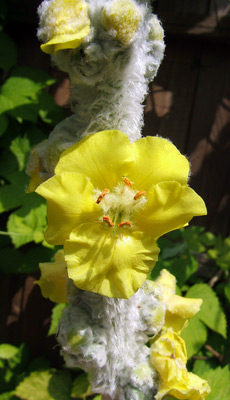 Now you could go the whole hog and have a wild flower
area or wild flower lawn, though unless you have a very large
garden with an area you can put aside to do this in I suggest
you don't. Why not? Because they look great in late
spring, but then they go-over when they've flowered, often literally
falling over and becoming something not very pretty at all.
You have to keep it at this stage if you want the full benefit
from it, then later on when you mow it down, it's all yellow
and takes ages to recover - fine for a meadow out in the countryside,
but not terribly attractive in your garden. I have tried this
in my not-that-large garden and I know several other people
who have tried it too, no-one I know has bothered to repeat
it.
Now you could go the whole hog and have a wild flower
area or wild flower lawn, though unless you have a very large
garden with an area you can put aside to do this in I suggest
you don't. Why not? Because they look great in late
spring, but then they go-over when they've flowered, often literally
falling over and becoming something not very pretty at all.
You have to keep it at this stage if you want the full benefit
from it, then later on when you mow it down, it's all yellow
and takes ages to recover - fine for a meadow out in the countryside,
but not terribly attractive in your garden. I have tried this
in my not-that-large garden and I know several other people
who have tried it too, no-one I know has bothered to repeat
it.
Instead, I find it's more successful for me as a gardener, to grow some appropriate plants mixed in with the rest of the garden, particularly as I'm likely to keep it going year after year rather than the one-off my wildflower meadow area was.
There are many such plants and they don't have to be wild ones to have value for wildlife, here are some I grow that are good garden plants and beloved by wildlife too:
Herbaceous
-
Verbascum - Mullein, (picture right)
great big leaves, 12" x 6" with a wonderful soft furry texture
in spring, flower spikes to 6ft that are dotted with individual
flowers, long lasting - a real magnet for hoverflies.
Biennial
-
Digitalis - Foxglove, old cottage
garden favourite, good for bees. Biennial
-
Lilies, wonderful large often scented
flowers that produce pollen to drive hoverflies barmy.
Perennial
-
Lavender, another magnet for pollinating
insects. Perennial
- Fennel, especially bronze fennel. A stately and attractive plant with wispy foliage is that is like mist from a distance (well I think it is anyway), flowers attract insects and seeds in the winter attract birds. Self-seeds, but less of a problem than growing them from seed, just pull up the ones you don't want. Perennial
Climbers
-
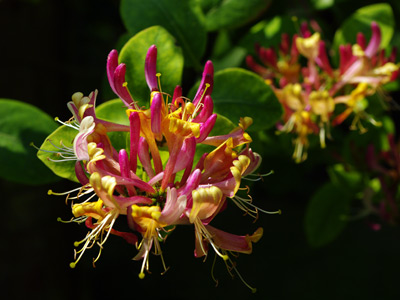 Lonicera - honeysuckle (picture right)
beloved cottage garden climber, grow up an arbour, through
a mature tree or an infrequently trimmed hedge. Flowers
are loved by many insects, berries in the autumn are favoured
by birds
Lonicera - honeysuckle (picture right)
beloved cottage garden climber, grow up an arbour, through
a mature tree or an infrequently trimmed hedge. Flowers
are loved by many insects, berries in the autumn are favoured
by birds -
Rambling
and scrambling roses, great
big roses, one in my garden is about 15ft wide and 12ft high
up a large conifer hedge. Flowers visited by bees and loads
of pollinating beetles, hips in the winter for the birds.
- Ivy, wild is best, if you can, leave it to do its own thing up and old tree, fence or wall. Bees go mad for the flowers which are produced usually long after any others in the garden and so are especially valuable, birds then love the berries which are also late. Not the prettiest plant, but often the only plant that will grow in a dark or difficult place in the garden.
Shrubs
-
Pyracantha, an often underestimated
plant, burglar proof (your house with it - that is), grow
as a wall shrub or bush, not too fussy about soil and grows
in semi-shade, flowers popular with many pollinating insects
and blackbirds in particular love the autumn berries.
-
Cotoneaster, Many wild and cultivated
varieties, almost doesn't matter which you have as they
are all wildlife-friendly. Flowers are an absolute favourite
for bees, birds love the berries.
- Buddleia, a fast growing shrub that is covered in summer by large panicles of (usually) lilac coloured flowers which in turn are often covered in butterflies and bees. Unfussy about soil, best in full sun.
Trees
- Fruit - Almost any fruit tree is wildlife friendly,
the blossom in spring and the fruit in late summer and autumn.
There will always be windfall fruit to leave for the birds,
if you don't want it littering the lawn up, then kick the
bruised windfall fruit into the nearest border. You won't
see it as the plant leaves will hide it, but the birds will
find it easily and what they miss will rot down and add
to the humus content of the border soil.
Crab Apple - Plum - Pears - Apple - All fruit trees
Advantages of growing wildlife
friendly plants:
- Increases biodiversity
- Many attractive plants in their own right
- Plants with life around them always seem more "planty"
to me than something that wildlife wouldn't consider approaching
Make your own compost - and use it too
 Composting organic waste is one of the oldest, easiest
and most effective forms of recycling that you can do.
Composting organic waste is one of the oldest, easiest
and most effective forms of recycling that you can do.
All plant material that comes from your garden can and should go onto a compost heap, likewise any potato peelings, carrot scrapings, cabbage outer leaves and so on. A compost bucket just outside the back door is better than one in the kitchen, doesn't take up kitchen space and prevents any smell and fruit flies in the summer. Tip it on the compost heap every few days.
Cooked food shouldn't be added as it can attract rats and mice, but this doesn't need to go to landfill as a bird-table is an ideal way of dealing with this, see below.
Ideally compost should be shredded and mixed on addition to the heap, but this is rarely possible especially for the usual piecemeal additions. I find the ideal is to have a commercial plastic compost bin (that the council gave away for free years ago, check with your council, they may cheap or subsidized ones) with lid that I add everything to initially and then mix it up, this is where the rotting starts and reduces the volume by about 3 or 4 fold. When this is full I move the contents to one of two larger long-term heaps. 3 or 4 initial bins full fill the main heap. When this is full and I need more room, I turn it upside down to a second long-term heap, this is then distributed when space is needed for more plant material.
Advantages of making your own compost:
- No transport requirement, no taking it down the skip.
- Makes valuable organic material to make your garden grow wonderfully
- Keeps nutrients in the garden, less need for additional fertilisers
- Cheaper than buying compost in bags and doesn't come from possibly endangered peat bogs
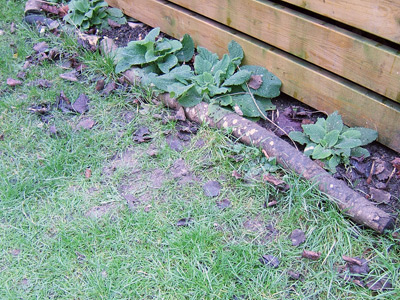 For larger branches and tree trunks, I cut them as long
as I can and try to use them in the garden to make frames for
climbers or border edging for beds, they don't last
forever, but at least as long as wooden edging you can buy and
are much more sympathetic to the garden situation.
For larger branches and tree trunks, I cut them as long
as I can and try to use them in the garden to make frames for
climbers or border edging for beds, they don't last
forever, but at least as long as wooden edging you can buy and
are much more sympathetic to the garden situation.
They will rot down, but provide a habitat and food for countless animals and fungi in your garden as they do so. I hold them in place with pegs cut from any scrap wood I have about 8" long and 2" wide cut to a point and bashed into the ground with a lump hammer, a single 2" nail fixes the peg to the branch, one every 3 feet or thereabouts is enough. As they age, they become covered in moss and become even more sympathetic to the garden environment.
Get a bird table
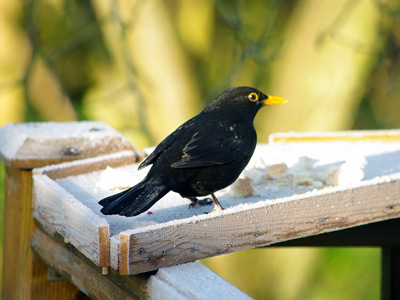 Almost all left overs can go on the bird
table, there is some bird that will eat just about
everything from bread to burnt pizza, hummus, browned avocados,
unwanted dried cheese, shredded wheat and excess cooked rice
to name just a few things that have gone on ours recently.
Almost all left overs can go on the bird
table, there is some bird that will eat just about
everything from bread to burnt pizza, hummus, browned avocados,
unwanted dried cheese, shredded wheat and excess cooked rice
to name just a few things that have gone on ours recently.
The trick is to cut everything up reasonably small, about the size of a sultana or thereabouts if you can manage it, as long as it's ok to eat, but not mouldy or rotten it's usually fine. Meat, fat and skin all go too, trimmings from bacon, ham, roasts etc.
Forget those twee bird tables with little thatched roofs, the most effective type I've found are open topped, we have two, one shown to the right that fits on the corner rails of our wooden decking and another similar platform that hangs from a tree using a piece of branch about 2" wide and 12" long to make it stable that we have used for about the last 10 years. They are very simple to make, about 12" by 18" (30 x 45cm) with a lip nailed around the edge to stop stuff falling off. There should be a gap at each corner of the lip however to help with cleaning the table which you should do at least every week - I use a scrubbing brush and water from a watering can.
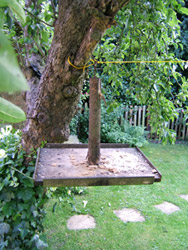 Ours
hangs from an old apple tree positioned in front of the kitchen
window, I used a branch as the vertical hanger to look
more rustic. The birds seem to like the fact that it swings
like a natural branch when they land on it, it also gives a
good clear view all around of any predators so making them feel
safer. It's useful to put some food on the ground too as some
species prefer to feed there while others will prefer the table.
Ours
hangs from an old apple tree positioned in front of the kitchen
window, I used a branch as the vertical hanger to look
more rustic. The birds seem to like the fact that it swings
like a natural branch when they land on it, it also gives a
good clear view all around of any predators so making them feel
safer. It's useful to put some food on the ground too as some
species prefer to feed there while others will prefer the table.
Advantages
- Recycles left-overs into bird-song
- Helps wild bird populations
- Brings birds into your garden
- Avoids smells from the bin and saves putting material into landfill
Pesticides and other chemicals
Best avoided, though I have to admit that I am partial to the occasional spray with a systemic insecticide when aphids start to take over my favourite plants - I'm not expecting forgiveness or understanding, it's just the way it is.
There are natural ways of fighting pests with soap solutions and arcane mixtures brewed from plants though I find that they don't really work - the odd smart-missile chemical spray is far more effective.
How to avoid chemicals in the garden (I do all these things too):
- If you get pests or diseases on a small part of a plant,
then consider just cutting that part off and burning it
or putting it in the "green/brown bin" or similar - if your
council provides one.
- If you can't really cut the part off, then you have
your hands, rub aphids off or pull them off up the stem,
a rub on the lawn gets you clean (ish) again. Caterpillars can
be put on the bird table.
- Hygiene especially in the autumn is important, don't
leave dropped leaves on the ground, pick them up and compost
them. If the plants has shown signs of disease, burn the
leaves or dispose of them outside the garden.
- Make and use garden compost (above) as your fertiliser.
Wee on your compost heap on a regular basis, it adds nitrogen
and gets the whole rotting process going.
- Bury old leather near large trees and shrubs, remove
plastic and metal bits from shoes and handbags first, leather
is high in nitrogen and rots slowly releasing its goodies
over a long time. I cut the leather into smallish pieces
6" x 3" ish, make a slit with a spade, open it up, slide
the leather in and close the slit up again.
- If you add extra fertiliser, make sure it is organic
and not man-made. I favour the slow acting blood, fish and
bone which as it has a N:P:K ratio of of 6:6:6 and
considering it's origins I call it the "Fertiliser of Beelzebub"
- you may of course make up your own amusing names.
- You can also make fertiliser from steeping fresh horse
manure, nettles or comfrey in water.
- Don't bother spraying your fence with preservative like
the ads say you should, it just sells preservative which
preserves the wrong bits anyway. Fences fail at the posts,
so brace the verticals and you'll do more than all those
chemicals ever could. Instead place wires and grow climbers
up your fences or plant shrubs in front of them to hide
them and appreciate the rustic way in which the wood ages.
Get a water butt or two or three
Catch the rain from the sky in a water butt before it disappears down the drain. We all know how important this is, and many of us are on a water meter.
Advantages
- Reduce water bills
- Reduce the need for reservoirs and lower water take-up from bore-holes
- Better for plants than tap water
- Beat hosepipe bans
Copyright 2000 - present. All Rights Reserved | Privacy Policy Statement
